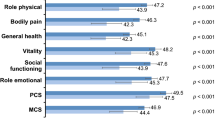Abstract
Cystinuria is a genetic cause of recurrent kidney stones which may be more recurrent and larger than more common non-cystine stones. They may have a greater impact on health-related quality of life (HRQoL). We measured this impact by surveying HRQoL in patients with stones, comparing non-cystine stone formers (NCSF) to cystine stone formers (CYSF) and both groups to normative values of the US population. We used SF-36v2 via an internet instrument. CYSF patients were recruited via cystinuria-related websites, two patient advocacy groups, and an active endourology practice. NCSF patients were recruited from the same practice and by email. Total n surveyed with scorable data: 214 CYSF and 81 NCSF. The participants included 128 men and 161 women. The group of CYSF were significantly younger (39 vs. 54 years) and suffered longer from kidney stones (255 vs. 136 months). CYSF patients had significantly more episodes of stones than NCSF patients in the last year (N = 108 CYSF, N = 20 NCSF). More frequent stones in the last year and mental comorbidities most often predicted worse scores in the individual HRQoL domains. However, cystine stone composition was a significant predictor of worse scores only for role emotional. Better scores in all SF-36 domains were associated with greater time since the last kidney stone event. Although kidney stones are often transient, kidney stone formers, regardless of stone composition, have a worse HRQoL than the standard US population, which has a normative score of 50, such as general health (41.2 ± 12.8), bodily pain (46.5 ± 11.8) and mental health (45.1 ± 12.6). CYSF are more frequent and severe stone formers compared with NCSF with a resulting greater, direct impact on the HRQoL of CYSF patients. Whether preventive strategies for cystinuria are being properly utilized by practitioners, and which strategies are most effective, should be established.


Similar content being viewed by others
References
Bryant M, Angell J, Tu H, Goodman M, Pattaras J, Ogan K (2012) Health related quality of life for stone formers. J Urol 188:436–440
Angell J, Bryant M, Tu H, Goodman M, Pattaras J, Ogan K (2012) Association of depression and urolithiasis. Urology 79:518–525
Penniston KL, Nakada SY (2007) Health related quality of life differs between male and female stone formers. J Urol 178(6):2435–2440
Saigal CS, Joyce G, Timilsina AR (2005) Direct and indirect costs of nephrolithiasis in an employed population: opportunity for disease management? Kidney Int 68:1808–1814
Lotan Y (2009) Economics and cost of care of stone disease. Adv Chronic Kidney Dis 16:5–10
Goldfarb DS (2002) Reconsideration of the 1988 NIH consensus statement on prevention and treatment of kidney stones: are the recommendations out of date? Rev Urol 4:53–60
Mattoo A, Goldfarb DS (2008) Cystinuria. Semin Nephrol 28:181–191
Dello Strologo L, Pras E, Pontesilli C, Beccia E, Ricci-Barbini V, de Sanctis L, Ponzone A, Gallucci M, Bisceglia L, Zelante L, Jimenez-Vidal M, Font M, Zorzano A, Rousaud F, Nunes V, Gasparini P, Palacin M, Rizzoni G (2002) Comparison between SLC3A1 and SLC7A9 cystinuria patients and carriers: a need for a new classification. J Am Soc Nephrol 13:2547–2553
Pizzi LT, Weston CM, Goldfarb NI, Moretti D, Cobb N, Howell JB, Infantolino A, Dimarino AJ, Cohen S (2006) Impact of chronic conditions on quality of life in patients with inflammatory bowel disease. Inflamm Bowel Dis 12:47–52
Bensalah K, Tuncel A, Gupta A, Raman JD, Pearle MS, Lotan Y (2008) Determinants of quality of life for patients with kidney stones. J Urol 179:2238–2243
Donnally CJ 3rd, Gupta A, Bensalah K, Tuncel A, Raman J, Pearle MS, Lotan Y (2011) Longitudinal evaluation of the SF-36 quality of life questionnaire in patients with kidney stones. Urol Res 39:141–146
Chung SD, Keller JJ, Lin HC (2012) Increased risk of depressive disorder within 1 year after diagnosis with urinary calculi in Taiwan. Psychiatry Res 198:332–333
Curhan GC, Willett WC, Rimm EB, Stampfer MJ (1993) A prospective study of dietary calcium and other nutrients and the risk of symptomatic kidney stones. N Engl J Med 328:833–838
Penniston KL, Nakada SY (2013) Development of an instrument to assess the health related quality of life of kidney stone formers. J Urol 189:921–930
Acknowledgments
We appreciate a thorough reading of the manuscript by John C. Lieske MD. This study was funded in part by the Susan Schott Research Fund. This work was also generously supported by the Rare Kidney Stone Consortium, a part of NIH Rare Diseases Clinical Research Network (RDCRN). Funding was provided by grant 1U54DK083908-01 from the NIDDK and the Office of Rare Diseases Research (ORDR), part of the National Center for Advancing Translational Sciences (NCATS). The views expressed in written materials or publications do not necessarily reflect the official policies of the Department of Health and Human Services; nor does mention by trade names, commercial practices, or organizations imply endorsement by the US Government.
Conflict of interest
F. Modersitzki has no conflict of interest; L. Pizzi has no conflict of interest; M. Grasso is a consultant for Karl Storz Endoscopy; D.S. Goldfarb is a consultant for Takeda and Astra Zeneca, is owner of Ravine Group and received honoraria from Mission Pharmacal.
Author information
Authors and Affiliations
Corresponding author
Rights and permissions
About this article
Cite this article
Modersitzki, F., Pizzi, L., Grasso, M. et al. Health-related quality of life (HRQoL) in cystine compared with non-cystine stone formers. Urolithiasis 42, 53–60 (2014). https://doi.org/10.1007/s00240-013-0621-4
Received:
Accepted:
Published:
Issue Date:
DOI: https://doi.org/10.1007/s00240-013-0621-4




